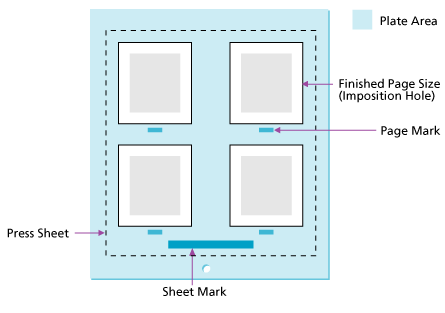This process template section determines how marks are handled during final output.
Sheet Marks
Identify the name and location of a PDF file containing sheet marks (for example variable marks, logo, and signoff line). Click Browse to locate and select a file.
Include print curve in calibration
When this check box is selected, the plate curve and print curve are applied to the mark. The curves applied are the ones selected in the Plate Curve list and Print Curve list in the Calibration & Screening section of the process template. When this check box is cleared, only the plate curve is applied. To prevent the application of the plate curve to a mark, select %%None%% in the Plate Curve list in the Calibration & Screening section of the process template.
Locate Sheet Marks Adjacent to
(See Sheet marks options explained and Sheet marks on final output.)
Select Left, Right, Bottom, or Top to determine on which edge of the paper or plate a sheet mark is placed.
The default setting is Bottom.
at Distance
(See Calculating the at distance value on final output.)
Determines where, relative to the edge, the mark is placed:
- Sheet marks are placed relative to the plate edge. Depending on the distance you type, you can place the sheet mark on the press sheet or on the plate.
- Page marks are placed relative to the finished page size (the imposition hole).
Justified
Select Left, Center, or Right to determine the justification for the sheet mark.
The default value is Center.
Unit Used for Variable Marks
Select the unit you want to use to measure variable marks—inch, cm (centimeter), mm (millimeter), or pts (points).
Imposition Marks Calibration
Select one of the following options to determine how imposition marks are calibrated.
- Print and plate curve—the plate curve and print curve are applied to the imposition mark. The curves applied are the ones selected in the Plate and Print Curve list in the Calibration & Screening section of the process template.
- Plate curve only—only the plate curve is applied
- Honor Calibration in Imposition—the plate and print curves are applied in a similar manner, according to whether calibration for the mark is enabled or disabled in the imposition software. To prevent the application of the plate curve to a mark, select %%None%% in the Plate Curve list in the Calibration & Screening section of the process template. This applies to Preps 5.2 and later; however, Preps 6.0 and later is required in order to edit Prinergy impositions.
Default Marks Font
Prinergy can populate variable marks with double-byte characters such as those used for the Japanese, Chinese, and Korean languages.
Here's an example of how you could use the feature:
- Create a Preps imposition file that includes a variable mark, such as
$[PageName]. - In Prinergy, in the Marks section of the imposition output process template, in the Default Marks Font box, type the exact name of the double-byte font that can be used in case the variable mark's original font was not a double-byte font. The font must reside either in a Prinergy-aware font folder or in the job's font search path.
- Submit the imposition file to Prinergy.
If the imposition file contains a page name with double-byte fonts, Prinergy outputs the file with these characters.
- Create a Preps imposition file that includes a variable mark, such as
Slugline
A slugline mark is a text or variable mark that you place on loose page, imposition, or final output. Instead of using Sheet Marks or Page Marks, you can use Slugline to quickly place a slugline mark.
A slugline mark does not need a PDF file, so you can easily place a mark without creating a PDF file. However, a slugline mark is just a line of text or a variable mark. You can only specify the text size.
- In the Slugline mark box, type the text or variable mark.
- In the Text size box, type the font size for the mark.
- In Place on media, specify the distance from left and from bottom.
- In Rotation, select 0, 90, 180, or 270 to rotate the mark counterclockwise in 90-degree increments.
From: (Left, Center, Right)—sets the horizontal alignment of the slugline mark and the origin edge that the From setting shifts the content from.
From: (Top, Center, Bottom)—sets the vertical alignment of the slugline mark and the origin edge that the From setting shifts the content from.
Note: If you are using a variable mark in your slugline, the _offset and _replace parameters and any page-oriented variables parameters and barcode variables, are currently not supported.
Replace variable marks in PDF content files
Select this check box to enable variable text marks (for example, $[color] or $[job]) to be replaced when those marks are found in content PDFs placed within an imposition. Content PDFs are PDFs which make up the content of the finished product, the printed, cut, and bound page(s).
Clearing this check box means that only variable marks in mark PDFs will be replaced and that any variables present in content PDFs will be left as is. For example, if $[color] appears within a content page it will still appear as $[color] in output.
IMPORTANT: When using this setting you must follow the procedure outlined in Partner Place Answer ID 69302. Failing to do so could result in serious output problems.
Text Marks Knock Out Content
By default, Variable marks overprint content, this setting will instead set those marks to Knock-out. Typically it will be used along with the setting ‘replace variable marks in content’
